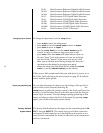
31
using custom input names If none of the default names seems quite right for a given source, you
may create a name of your own choosing, up to seven characters long.
To do so,
• navigate to the
NAME= level of the menu system, and
• if necessary, use the
volume knob (or use the volume
buttons
on the remote) to choose the name INPUT (or
whatever other custom name might have been entered);
• press enter to enter the single-character editing mode;
• use the volume knob to select each character in turn,
pressing
enter each time to move to the next character;
• when you
enter the seventh character, you are done.
(Blank spaces count as characters.)
naming an input “SSP” Introduced in 1993, the Mark Levinson SSP mode provides a clean so-
lution to the problem of integrating a state of the art two-channel sys-
tem with a multichannel system. By routing the front Left and Right
outputs of the surround sound processor through the Nº383, and nam-
ing that input “SSP,” you can enjoy both systems without compromise.
If this scenario is important to you, please see the section entitled “Us-
ing Surround Sound Processors” later in this manual for more detail. In
brief, when the Nº383 accesses an input named SSP, it defeats the nor-
mal function of the volume control, going to a fixed gain for that input.
In so doing, it allows the multichannel volume control to control the
relative volumes of all the speakers in the system, without having to be
concerned about a now-redundant volume control in the Nº383. When
you wish to listen to your two-channel system, simply choose any other
input on the Nº383 and place your surround sound processor in
standby.
Important note: Make sure that the volume on your surround processor
is turned down before changing the input name on
your Nº383 to SSP. When the preamp effects this
change, it abdicates its control over the volume of your
front left and right speakers, allowing the surround
processor to handle it instead.
setting input gain Each input in the Nº383 can be set for one of four preamplifier gain
settings: 0 dB, 6 dB, 12 dB, or 18 dB. The concept is to use as much gain
as an individual source may require in order to drive the power ampli-
fier section to adequate levels, without introducing unnecessary gain
that might result in a distorted signal.


















